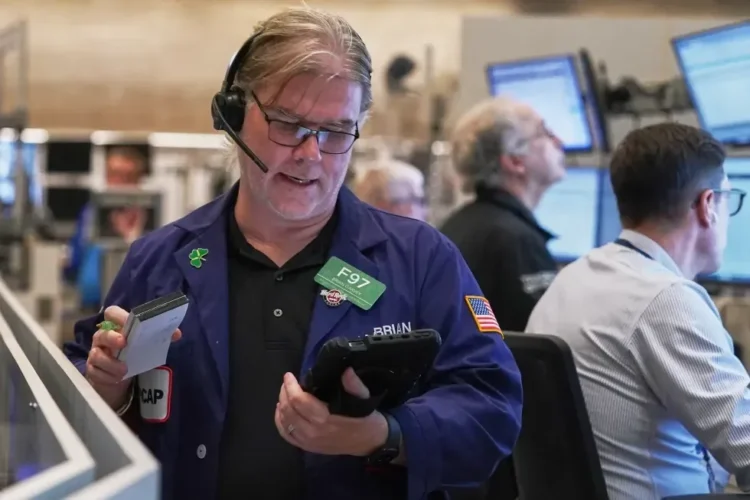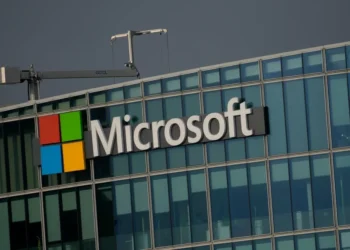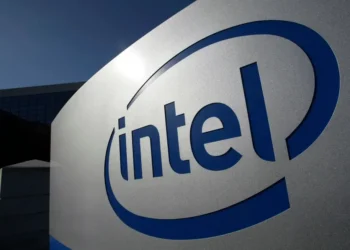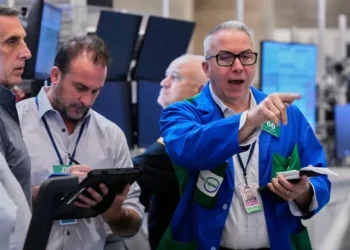NEW YORK — Wall Street rebounded sharply on Monday, led by Big Tech and artificial intelligence (AI) powerhouses such as Nvidia, helping major indexes recover much of last week’s declines.
The S&P 500 rose 1.2%, clawing back over two-thirds of its first weekly loss in nearly a month. The Nasdaq composite jumped 1.9%, driven by surging tech stocks, while the Dow Jones Industrial Average added 183 points, or 0.4%, as of mid-morning trading.
Nvidia Leads AI Rally
Nvidia was the market’s strongest performer, climbing 4% and fueling a wider rebound among AI-related companies. The chipmaker had been at the center of last week’s sell-off, as investors questioned whether enthusiasm for AI had inflated valuations to unsustainable levels — drawing comparisons to the dot-com bubble of the early 2000s.
Taiwan Semiconductor Manufacturing Co. (TSMC) — one of Nvidia’s key suppliers — saw its U.S.-traded shares jump 3.1% after reporting a 17% year-over-year revenue increase in October. Although still robust, the growth represented a slowdown compared to previous quarters.
Another major AI player, Palantir Technologies, surged 8%, marking the biggest gain in the S&P 500.
Despite the strong showing from tech giants, most other stocks in the index fell, underscoring how a few mega-cap companies continue to drive market momentum.
Health Insurers Decline Amid Policy Uncertainty
The broader rally was tempered by losses in the healthcare sector. Health insurers dropped as lawmakers in Washington remained divided over whether to extend expiring health care tax credits. The dispute has prolonged what is now the longest government shutdown in U.S. history.
Although the Senate began initial steps Sunday to end the shutdown, uncertainty persisted. President Donald Trump added to the debate over the weekend, suggesting in a social media post that subsidies sent to “money sucking” insurance companies should instead go directly to individuals to purchase coverage.
Shares of Humana fell 2.6%, while Cigna slipped 0.7%.
Shutdown Ripples Across the Economy
The effects of the shutdown have begun to ripple through the economy, with thousands of flights canceled over the weekend amid air traffic controller shortages. Some controllers, unpaid for weeks, have stopped reporting to work, worsening staffing issues at major airports.
The shutdown has also delayed key government economic reports, leaving investors without crucial data on employment, inflation, and growth. Analysts warn that once the backlog of reports is released, unexpected data could disrupt market expectations for Federal Reserve interest rate cuts.
Investors Watching the Fed
Markets remain focused on the Federal Reserve’s next moves. The consensus view is that the Fed will continue lowering its benchmark interest rate to support a slowing job market and stimulate growth.
Lower rates generally boost stock prices by making borrowing cheaper and encouraging investment, but Fed officials have warned they may pause rate cuts if inflation reaccelerates.
With limited economic data available, investors have turned their attention to corporate earnings for insight into the economy’s health.
Strong Corporate Earnings Boost Confidence
So far, roughly 80% of S&P 500 companies have reported stronger-than-expected earnings for the summer quarter. That trend helped justify the stock market’s sharp rise since April.
Tyson Foods shares rose 2.1% after posting quarterly profits that exceeded forecasts, aided by price hikes of 11% to 17% for beef and pork products.
According to Bank of America strategist Savita Subramanian, corporate outlooks remain generally positive, with profit expectations for 2026 approaching pre-tariff announcement levels. Subramanian noted that companies have been under pressure to validate high valuations through stronger earnings.
Global Markets Rally in Sync
Overseas markets also reflected renewed investor optimism. South Korea’s Kospi surged 3%, buoyed by semiconductor leaders SK Hynix (+4.5%) and Samsung Electronics (+2.8%), both key partners in the AI supply chain. European markets also posted modest gains.
In the bond market, the 10-year U.S. Treasury yield inched down to 4.10% from 4.11% late Friday, signaling stable demand for government debt.
This article was rewritten by JournosNews.com based on verified reporting from trusted sources. The content has been independently reviewed, fact-checked, and edited for accuracy, tone, and global readability in accordance with Google News standards.
Stay informed with JournosNews.com — your trusted source for verified global reporting and in-depth analysis. Follow us on Google News, BlueSky, and X for real-time updates.
JournosNews.com follows Google News content standards with original reporting, verified sources, and global accessibility. Articles are fact-checked and edited for accuracy and neutrality.














